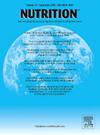用预测方程和全因死亡率和特定死亡率估算日本的水分周转:一项横断面地级市生态研究。
IF 3.2
3区 医学
Q2 NUTRITION & DIETETICS
引用次数: 0
摘要
目的:虽然水对维持生命和健康至关重要,但据我们所知,水周转量(WT)与死亡率的关系尚不清楚。我们的目的是1)确定WT的年平均值和方差,2)评估WT与日本所有47个县的死亡率之间的关系。方法:这项横断面的地级市生态研究使用了政府调查提供的地级市数据。WT的计算考虑了生活方式和环境因素,使用了先前由国际双标签水数据库组开发的方程。每个县被划分为WT四分位数。我们从2015年生命统计数据中获得了年龄标准化死亡率的数据。采用多变量泊松回归模型计算病死率(RR)。结果:男性WT的年平均值和方差分别为3771和990 mL/d,女性为3084和990 mL/d。在调整混杂因素后,与WT最高四分位数的县相比,WT最低四分位数的县与全因死亡率RR较高相关(男性:RR = 1.07[95%置信区间(CI) = 1.02-1.11];女性:RR = 1.05 [95% CI = 1.00-1.11])和中风(男性:RR = 1.16 [95% CI = 1.00-1.33];女性:RR = 1.18 [95% CI = 1.01-1.42])。在调整了运动习惯后,这种关联稍微弱一些,尤其是在女性中。结论:我们的研究结果表明,日本的WT存在较大的地区和季节差异,并且由于低WT导致的超额死亡风险可能部分由体育活动解释。本文章由计算机程序翻译,如有差异,请以英文原文为准。
Water turnover estimated by prediction equation and all-cause and cause-specific mortality in Japan: A cross-sectional prefecture-level ecological study
Objective
Although water is essential for maintaining life and health, the association of water turnover (WT) with mortality is, to our knowledge, unknown. We aimed to 1) determine the annual mean and variance of WT and 2) evaluate the association between WT and mortality in all 47 prefectures in Japan.
Methods
This cross-sectional, prefecture-level ecological study used data from government surveys that provided prefecture-level data. WT was calculated considering lifestyle and environmental factors using an equation previously developed by the international doubly labeled water database group. Each prefecture was classified into a WT quartile. We obtained data on age-standardized mortality from the 2015 Vital Statistics. The mortality rate ratio (RR) was calculated using a multivariable Poisson regression model.
Results
The annual mean and variance of WT were 3771 and 990 mL/d in men and 3084 and 990 mL/d in women, respectively. After adjusting for confounders, compared to the prefecture in the highest WT quartile, those in the lowest WT quartile were associated with a higher mortality RR for all-cause (Men: RR = 1.07 [95% confidence interval (CI) = 1.02–1.11]; Women: RR = 1.05 [95% CI = 1.00–1.11]) and stroke (Men: RR = 1.16 [95% CI = 1.00–1.33]; Women: RR = 1.18 [95% CI = 1.01–1.42]). This association was moderately weaker when adjusted for exercise habits, especially among women.
Conclusions
Our findings indicate large regional and seasonal variations in WT in Japan and that the risk of excess death due to lower WT may be partially explained by physical activity.
求助全文
通过发布文献求助,成功后即可免费获取论文全文。
去求助
来源期刊

Nutrition
医学-营养学
CiteScore
7.80
自引率
2.30%
发文量
300
审稿时长
60 days
期刊介绍:
Nutrition has an open access mirror journal Nutrition: X, sharing the same aims and scope, editorial team, submission system and rigorous peer review.
Founded by Michael M. Meguid in the early 1980''s, Nutrition presents advances in nutrition research and science, informs its readers on new and advancing technologies and data in clinical nutrition practice, encourages the application of outcomes research and meta-analyses to problems in patient-related nutrition; and seeks to help clarify and set the research, policy and practice agenda for nutrition science to enhance human well-being in the years ahead.
 求助内容:
求助内容: 应助结果提醒方式:
应助结果提醒方式:


